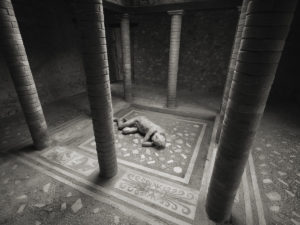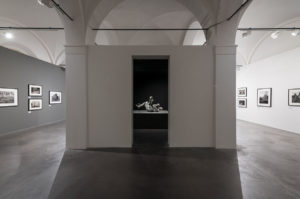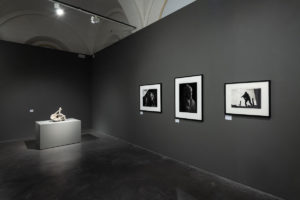To remember an event, a place or a face, one must live it, observe it. If this does not happen, taking a photograph is the best way to compensate for this lack: the power of images, in fact, consists precisely in triggering mechanisms such as memory, imagination and identification. All this happens in Requiem for Pompei. The personal exhibition of the Japanese photographer Kenro Izu (Osaka, 1949), inaugurated at MATA in Modena and promoted by the Modena Arti Visive Foundation together with the Archaeological Park of Pompeii, not only opens the doors of one of the most evocative places in Italy, but requires, above all, to stop and reflect on the essence and legacy of that place.
The fifty-five photographs exhibited, entrusted to the curatorship of Chiara Dall’Olio and Daniele De Luigi and visible until April 13th 2020, do not presuppose the intention to return a documentation of the excavations or their reconnaissance. As the title suggests, Izu’s intent is rather to commemorate the tragic event that hit Pompeii in order to perpetuate its memory. To fix the corners and foreshortenings in one click to eternally freeze the image. Izu, for the occasion, also places some casts of the victims of the eruption in focal points of the city, such as the Forum and the Amphitheater, in order to take them back together with the remains. In this way, between poetry and pain, the bodies establish a profound dialogue with the surrounding context, becoming protagonists of his visual prayer. His gesture amplifies the experience of vision, which intensifies to become a sharing: Izu lets others – or we – continue prayer, sharing the memory of a timeless pain that has affected the past, but that may manifest itself again in the future.
It is not the first time that Izu decides to commemorate ancient places: already with the Sacred Places series, which began in 1979, he is confronted with the evocative atmosphere of sites such as Stonehenge, Palmyra and Machu Picchu. The spiritual bond that he establishes with them is immediately perceived by observing his works, in which the photographic medium seems to constitute a sort of passage, a temporal passage useful for understanding nature, the very essence of those places. In Requiem for Pompei this ritual is renewed by involving the spectator even more decisively: the photographic series, realized in 2015, captures our attention to the point of projecting us back in time, making us enjoy the drama – and at the same time the beauty – of a city unique in the world. Izu’s contribution to making photographs through the use of the optical bench contributes in all this, an instrument already poetic in itself that allows to obtain highly sharp images: the contrasts of black and white thus enhance the mystical aura of the place and concur to make one appreciate the details even more.
In addition to the photographic apparatus, the exhibition also exhibits some casts from the Archaeological Park of Pompei, the same that Izu positioned and immortalized in his photographs. Their presence intensifies the pàthos, giving body to the imagined drama. This creates a sort of short circuit of the vision: it is like witnessing the materialization of figures observed in an old family album. In this way, we realize that the photographed bodies, although today have sculptural features, are real and that, above all, they have enjoyed a real life in the past. The short circuit also leads us to understand that even pain and suffering were real – they can be “touched”. The work of Kenro Izu is, therefore, a further testimony of the intrinsic strength of photography: it is not only able to immortalize in order to perpetuate, to evoke in order to remember, but it is also capable of attesting what is thought to be doubtful, to give body to something that could be considered true – and in this case it is completely. To put it in the words of Sontag, “the images are […] more real than anyone had supposed.”
Antongiulio Vergine
Info:
Kenro Izu. Requiem for Pompei
curated by Chiara Dall’Olio e Daniele De Luigi
6 December 2019 – 13 April 2020
FMAV – MATA
Via della Manifattura dei Tabacchi 83, Modena
 Kenro Izu, Casa degli Amorini Dorati, Pompei, 2016
Kenro Izu, Casa degli Amorini Dorati, Pompei, 2016
 Kenro Izu, Requiem for Pompei, Installation View, Fondazione Modena Arti Visive, MATA, Modena, 2019, Photo credits – Rolando Paolo Guerzoni
Kenro Izu, Requiem for Pompei, Installation View, Fondazione Modena Arti Visive, MATA, Modena, 2019, Photo credits – Rolando Paolo Guerzoni
 Kenro Izu, Requiem for Pompei, Installation View, Fondazione Modena Arti Visive, MATA, Modena, 2019, Photo credits – Rolando Paolo Guerzoni
Kenro Izu, Requiem for Pompei, Installation View, Fondazione Modena Arti Visive, MATA, Modena, 2019, Photo credits – Rolando Paolo Guerzoni

Born in Campi Salentina (LE). After the three-year degree in Technologies for the Conservation and Restoration of Cultural Heritage at the University of Salento, I attend the Master of Science in Visual Arts at the University of Bologna. I collaborated with Galleria d’Arte Maggiore g.a.m. (Bologna) and with MUMA – Museum of the Ancient Sea in Nardò (LE). I am interested in events concerning contemporary art, in particular those related to video-photographic and performative practices. I write for ATPdiary and Juliet Art Magazine.






NO COMMENT